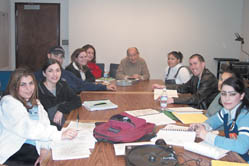Arpik Paraghamian
staff writer

A group of nine students have spent three weekends, Feb. 7,8; 14, 15; and 21, 22, looking at slides of ancient structures in a far away place as they studied something little is known about, Armenian Architecture. The class is part of the Armenian Studies Program at Fresno State and is being taught by Dr. Dickran Kouymjian, who developed the course at the American University of Beirut in the early 1970s.
Dr. Kouymjian started teaching Armenian architecture when there were no other courses being taught on the subject in any American or European university on a regular basis. Today, the Armenian Studies Program at Fresno State is among one of two universities in the country to offer regular classes devoted to Armenian art. “Medieval architecture and miniature painting have been among the corner-stones of the Armenian Studies Program and its minor,” Professor Kouymjian said.
This particular Armenian Architecture class looks into the construction of Church buildings in the fourth century and after, which was a major event in the history of the Armenians. Dr. Kouymjian hopes his students will “take away the notion that in Armenia there was an extraordinary activity of church architecture, innovative in all its aspects, in the early Christian centuries and again in the middle-ages,” he said.
The class at Fresno State uses Professor Kouymjian’s book entitled, Arts of Armenia as the backdrop to the colorful slides that explore churches such as Holy Etchmiadzin, Aghtamar, and St. Hripsime. Even students who have not been to Armenia to see these historical sites can understand something about what the structure looks like from the inside and out.
Gabriel Halls, 22, is a history major who is taking the course because of his appreciation for ancient history. He said the slides make the class come alive. Dr. Kouymjian’s book, the Arts of Armenia, Lisbon, 1992, can also be found on the Armenian Studies Program website (www.csufresno.edu/Armenian Studies) along with images of Armenian churches (and other arts), some in fair condition, others in ruins.
Ground plans for individual churches are also something the class studies. Dr. Kouymjian hopes his students will learn to read the different types of ground plans and be able to tell that buildings have different forms for different reasons. Dr. Kouymjian, who says the course changes each time he teaches it, is having his students update the information that is currently available on the ASP website as a class project. Each student has chosen a specific style of an Armenian church to study more closely.
 Hye Sharzhoom Armenian Action
Hye Sharzhoom Armenian Action